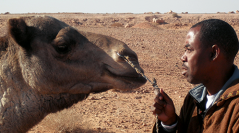

 Anthropozoologica
57 (9) - Pages 211-221
Anthropozoologica
57 (9) - Pages 211-221The metatarsal bone is one of the strongest bone in Ungulates and can provide various information about live animal. A sample of 86 metatarsal bones of 43 adult dromedaries (Camelus dromedarius Linnaeus, 1758) was studied. Two breeds were compared, with a total of 22 males and 21 females, organised in four groups: 13 Sahraoui females, 14 Sahraoui males, nine Targui females and seven Targui males. Prior to the osteometric study, biometric parameters (body weight [BW] and height at the withers [HW]) were measured. For each bone, the area of the proximal articular surface was calculated, and the proximal width and thickness were measured. No differences were observed between the left and right sides of each individual and therefore analysis was done only for the right side. The multivariate analysis (PCA) carried out on the articular surfaces and proximal linear measurements highlights sexual dimorphism, however, no statistical difference was noted between the two breeds. The best predictive model for obtaining body weight using osteometric measurements involves the “step-by-step” procedure which only contains one predictive measurement, namely the BpT (the metatarsal proximal width): BW = 128.88*BpT –302.55. Inclusion of the articular surfaces does not improve the prediction of weight in a bivariate model. However, taking into account the total surface area (SA) allows the body weight to be predicted using the following formula: BW = 21.728*SA + 136.840. Finally, no measurements allow the animal’s height at the withers to be estimated with a simple bivariate model.
Camel, Sahraoui breed, Targui breed, metapodial bone, metatarsal bone, osteometry, zooarchaeology.